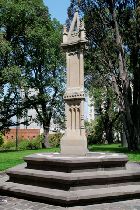Multimedia Content

Pioneer Monument, 1871, by Samuel Craven, courtesy of City of Melbourne.
Details
Pioneer Monument
Samuel Craven
Sandstone obelisk
1871
Flagstaff Gardens
Flagstaff Gardens once had special significance for the people of Melbourne. It was a place of hope and a place of sorrow. Early colonists could sight incoming ships from this high point, which brought tangible links with the old country; and known as Burial Hill, it was also the city's first burial ground. This latter role is reflected well in the Gothic architecture of the memorial, for as if wrested from an English church it is a reminder that this final resting place for an estimated six early settlers is a long way from 'home'.
The rapid growth of Melbourne made the site unsuitable as a cemetery, so a new burial ground was established at what is now Queen Victoria Market. Save for two wattle trees, the graves of the first buried went unmarked until 1871. The Department of Public Works then commissioned a sandstone obelisk by Samuel Craven for this purpose, its pointed uppermost section now missing. The memorial was erected in April 1871, and at the time of its unveiling a large cross was cut into the lawns surrounding it. Its inscription reads: 'Erected in 1871/ to the memory of/ some of the earliest of the pioneers of this colony/ whose remains were interred near this spot'.
